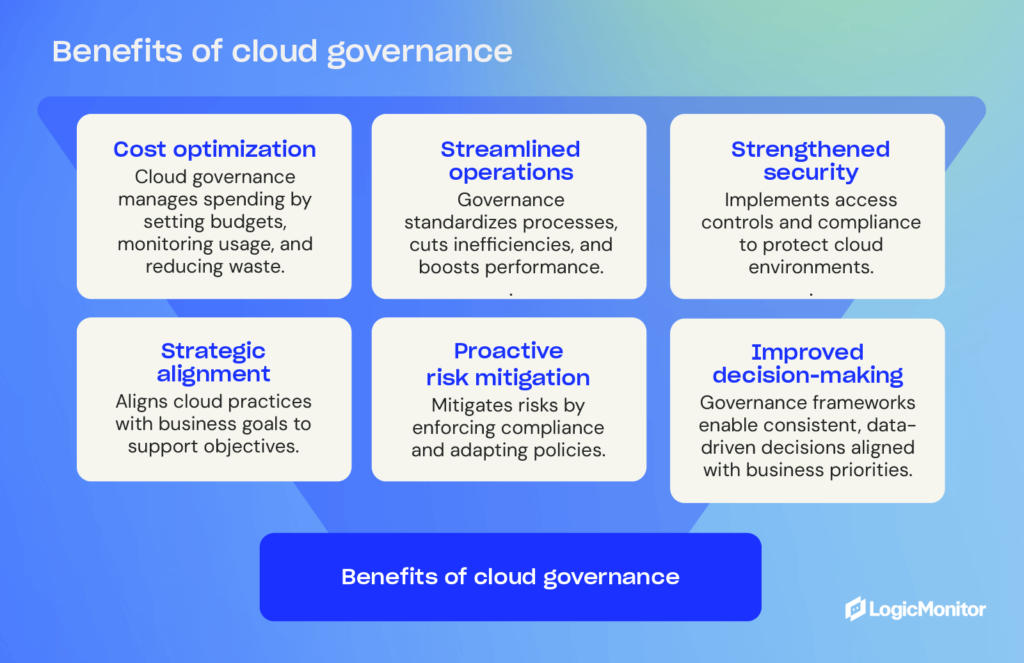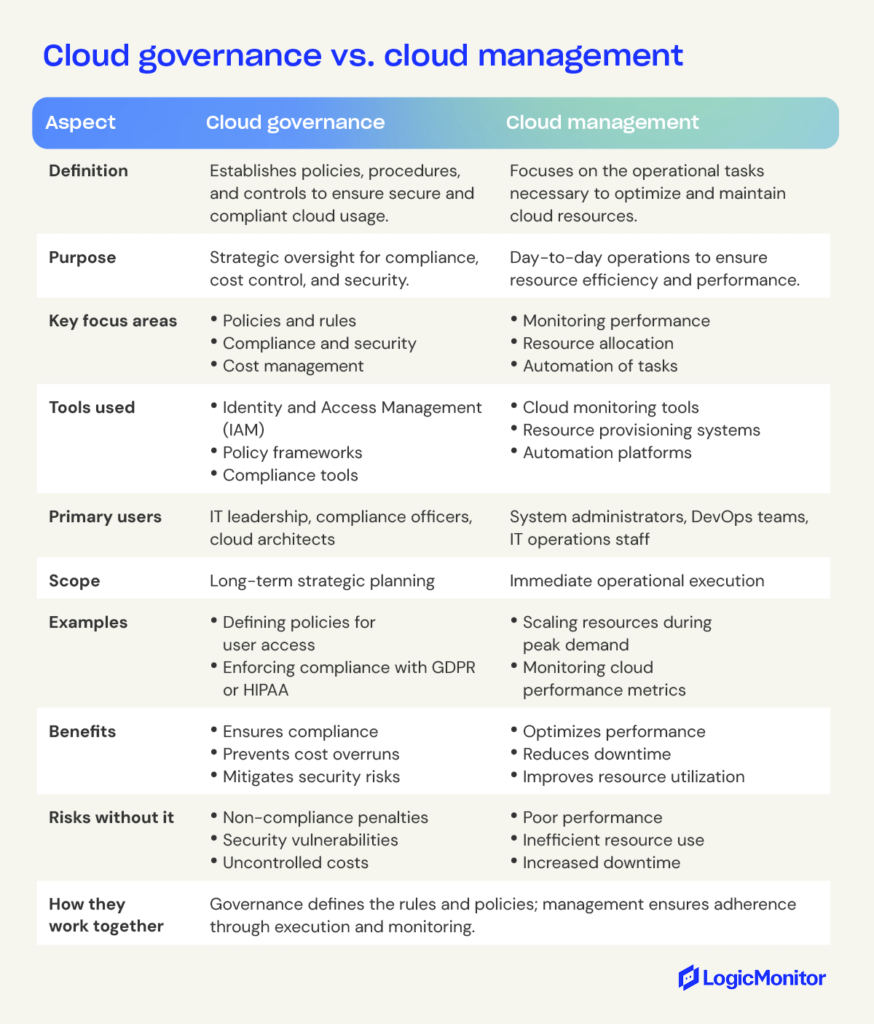Cloud governance vs. cloud management


The cloud has revolutionized the way businesses operate. It allows organizations to access computing resources and data storage over the internet instead of relying on on-premises servers and infrastructure. While this flexibility is one of the main benefits of using the cloud, it can also create security and compliance challenges for organizations. That’s where cloud governance comes in.
Cloud governance establishes policies, procedures, and controls to ensure cloud security, compliance, and cost management. In contrast, cloud management focuses on operational tasks like optimizing resources, monitoring performance, and maintaining cloud services.
Here, we’ll compare cloud governance vs. cloud management and discuss how you can use them to improve your organization’s cybersecurity posture.
Cloud governance is managing and regulating how an organization uses cloud computing technology. It includes developing policies and procedures related to cloud services and defining roles and responsibilities for those using them.
Cloud governance aims to ensure that an organization can realize the benefits of cloud computing while minimizing risks. This includes ensuring compliance with regulatory requirements, protecting data privacy, and maintaining security.
Organizations should also develop policies and procedures related to cloud services. These should be designed to meet the organization’s specific needs and be reviewed regularly.
Cloud governance is important because it provides a framework for setting and enforcing standards for cloud resources. This helps ensure that data is adequately secured and service levels are met. Additionally, cloud governance can help to prevent or resolve disputes between different departments or business units within an organization.
When developing a cloud governance strategy, organizations should consider the following:
An effective cloud governance strategy will address all of these factors and more. It should be tailored to the organization’s specific needs and reviewed regularly. Additionally, the strategy should be updated as new technologies and regulations emerge.
Organizations without a cloud governance strategy are at risk of data breaches, regulatory non-compliance, and disruptions to their business operations. A well-designed cloud governance strategy can help mitigate these risks and keep an organization’s data safe and secure.
Cloud governance is built on principles essential for ensuring that cloud resources are used securely, efficiently, and according to business objectives. Sticking to these principles lets your organization lay out clear expectations, streamline processes, and minimize several risks associated with cloud computing. By implementing these guidelines, you can establish a robust governance framework for secure and effective cloud operations:
A framework for cloud governance provides guidelines and best practices for managing data and applications in the cloud. It can help ensure your data is secure, compliant, and aligned with your business goals.
When choosing a framework for cloud governance, consider a few key factors:
Implementing a cloud governance framework can be challenging, but it’s essential to have one in place to ensure the success of your cloud computing initiative. Here are a few tips to help you get started:
Before implementing a cloud governance framework, you need to know what you want to achieve. Do you want to improve compliance? Reduce costs? Both? Defining your goals will help you determine which policies and procedures need to be implemented.
Cloud governance affects everyone in an organization, so it’s crucial to involve all stakeholders, including upper management, IT staff, and business users. Getting buy-in from all parties will make implementing and following the governance framework easier.
Don’t try to do too much with your cloud governance framework. Start small and gradually add more policies and procedures as needed. Doing too much at once will only lead to confusion and frustration.
Many cloud governance tools can automate tasks such as compliance checks and cost reporting. These tools can reduce the burden on your staff and make it easier to enforce the governance framework.
Implementing cloud governance gives organizations a structured approach to managing cloud resources, keeping cloud management aligned with business goals, and reducing risks. Using this framework, you can gain better control over your cloud environments so they operate more efficiently while safeguarding sensitive data. Cloud governance offers the following advantages for navigating the complexities of modern cloud computing.

Cloud governance sets the rules; cloud management ensures the game is played efficiently.
Cloud management is the process of governing and organizing cloud resources within an enterprise IT infrastructure. It includes the policies, procedures, processes, and tools used to manage the cloud environment.
Cloud management is the process of governing and organizing cloud resources within an enterprise IT infrastructure. It includes the policies, procedures, processes, and tools used to manage the cloud environment.
Cloud management aims to provide a centralized platform for provisioning, monitoring, and managing cloud resources. This helps ensure that all resources are utilized efficiently and that the environment complies with corporate governance policies.
Cloud management is critical for businesses because it helps them optimize their cloud resources, control costs, and facilitate compliance with regulatory requirements. Cloud management tools help companies automate the provisioning, monitoring, and maintenance of their cloud infrastructure and applications.
Organizations increasingly turn to cloud-based solutions to help them run their businesses, so it’s crucial to understand how cloud management works. By definition, cloud management is administering and organizing cloud computing resources. It includes everything from provisioning and monitoring to security and compliance.
Several different tools and technologies can be used for cloud management, but they all share a common goal: to help organizations maximize their investment in cloud computing.
The first step in effective cloud management is understanding the different types of clouds and how they can be used to meet your organization’s needs. There are three main types of clouds: public, private, and hybrid.
A cloud management platform (CMP) is software that enables an enterprise to monitor and control all aspects of its cloud computing infrastructure and resources. A CMP typically provides a unified, web-based interface through which an administrator can provision, configure, and manage public and private cloud resources.
A cloud management platform (CMP) gives you centralized control over your cloud resources, helping to optimize operations while maintaining flexibility and security. Through a combination of cloud processes and tools in a single interface, CMPs help simplify management tasks and make the platform worth the investment. Here are some key benefits that make cloud management platforms ideal for organizations that rely on modern cloud environments:
The secret to cloud efficiency, security, and scalability is balancing governance and management.
Cloud governance is the set of processes, policies, and controls an organization uses to manage its cloud services. Cloud management is the day-to-day operational tasks involved in managing a cloud environment, such as provisioning and configuring resources, monitoring usage and performance, and ensuring security.

The two concepts are closely related, but there are some important differences. Cloud governance is primarily concerned with setting and enforcing standards for how the cloud is used within an organization. It defines who can access which resources, what they can use them for, and how they can be configured. Cloud management, on the other hand, is focused on actually carrying out those standards on a day-to-day basis.
Organizations need both cloud governance and management to ensure that their use of cloud resources is safe, compliant, and efficient. Cloud governance provides the framework for decision-making and sets the expectations for how cloud resources will be used. Cloud management ensures that those decisions are carried out properly and resources are used as intended.
For instance, a retail company experiencing seasonal spikes in demand might develop a cloud governance framework with policies for increasing available IT resources during peak shopping periods. These policies could also help facilitate compliance with data privacy laws like GDPR and define access controls to protect sensitive customer information. Meanwhile, cloud management tools would implement these policies by allocating additional computing resources during Black Friday, monitoring usage to prevent performance issues, and decommissioning unused resources afterward to avoid unnecessary costs.
In another case, a financial institution might rely on cloud governance to establish policies that restrict access to customer financial data to authorized personnel only through multi-factor authentication mechanisms. Governance policies might also require regular compliance audits to ensure systems meet industry regulations and standards. Cloud management tools enforce these rules using automated monitoring to detect and alert administrators of unusual activity, such as unauthorized access attempts or data anomalies.
Implementing effective cloud governance and management takes careful planning and execution. By adopting best practices, you can be confident your cloud environments are secure and efficient and support your business objectives. By following these best practices, your organization can create a cloud governance and management strategy that builds long-term success in your cloud initiatives:
Develop a comprehensive cloud governance framework that aligns with your organization’s goals and regulatory requirements. Define data storage, access control, compliance, and risk management policies. Ensure the framework addresses key areas like resource provisioning, decommissioning, and cost monitoring.
Include stakeholders in creating a strategy that balances efficiency with risk management for all operations, such as IT, legal, compliance, and business administration. Collaboration ensures alignment, avoids siloed approaches, and encourages continued communication across all departments.
Implement tools that automate routine management tasks like resource provisioning, performance monitoring, and compliance checks. Automation reduces human error and helps to ensure the consistent application of policies, freeing up IT teams for higher-value tasks.
Use cloud management platforms to monitor resource utilization, performance metrics, and costs in real-time. Identify underutilized resources or unnecessary expenditures and optimize configurations to reduce waste.
Integrate security measures such as multi-factor authentication, encryption, and regular vulnerability assessments into your cloud management practices. Security should be a cornerstone of your governance policies, especially if your organization handles sensitive information like health or financial data.
Routinely audit your cloud environment to make sure your system remains compliant with governance policies and industry regulations. Use these audits to identify gaps, improve policies, and validate that your management practices meet organizational goals.
Maintain up-to-date documentation of governance and management policies, and keep them easily accessible to all relevant personnel. Conduct training sessions to train teams on these policies to keep everyone up-to-speed on current practices and requirements.
Design strategies that can accommodate organizational growth. Whether you’re adding new applications or transitioning to a hybrid cloud model, ensure your framework is adaptable to future needs.
Define key performance indicators (KPIs) to measure the effectiveness of your governance and management efforts. Example KPIs might include cost savings, compliance audit results, or system uptime metrics.
The cloud landscape evolves rapidly — your governance and management strategies should, too. Regularly evaluate and update existing policies to keep up with emerging technologies or regulations. Incorporate lessons learned from audits or incidents into your new policies and practices.
Cloud governance and management are critical for maintaining secure, efficient, cost-effective cloud environments. Together, they provide the oversight and operational structure necessary to address key challenges organizations face when using the cloud. From managing costs to enhancing performance, the right governance and management strategies align cloud resources with business objectives while minimizing risks. Here are some core use cases where cloud governance and management prove to be indispensable:
Cloud governance and management tackle the distinct challenges of operating in cloud environments. From controlling costs to optimizing performance, these strategies work together to create an efficient and adaptable cloud ecosystem. By combining cloud governance and management, organizations in these industries can address their unique challenges, stay compliant, and enhance reliability:
A healthcare provider implementing a cloud-based patient records system must meet stringent compliance requirements like HIPAA. Cloud governance establishes policies for access controls, data encryption, and compliance audits to protect patient data. Cloud management tools enforce these policies, automatically flagging unauthorized access attempts and keeping system configurations compliant with the most current regulatory standards.
A retail company preparing for holiday sales uses cloud governance to set policies for scaling resources during peak demand while controlling costs. Governance frameworks dictate thresholds for provisioning additional servers or storage based on projected traffic. Cloud management tools automatically scale resources up or down, monitor performance, and decommission unused resources once demand subsides.
A financial institution using cloud-hosted trading platforms depends on real-time data accuracy, real-time observability, and high availability. Cloud governance ensures robust policies for disaster recovery and data replication. At the same time, cloud management tools monitor system performance and uptime, sending alerts if performance metrics fall below SLA-defined thresholds.
An online learning platform sees a surge in users during enrollment periods. Cloud governance defines policies to maintain application availability and enforce data privacy regulations like FERPA. Cloud management tools dynamically allocate computing power to optimize user experiences, even during high-demand periods.
Cloud governance and cloud management are two important aspects of working with the cloud. Each has its own benefits and importance, and it is essential to understand both before deciding to move to the cloud.
The framework for cloud governance provides guidelines for working with the cloud safely and efficiently. The principles of cloud governance ensure that data security and privacy are always considered. Cloud management platforms provide an easy way to manage all your clouds from one central location, giving you more control over your data.
Understanding cloud governance and cloud management is key to building a secure, efficient, and scalable cloud environment. These complementary strategies will help your organization balance oversight and operations, keeping cloud resources aligned with business goals while reducing risks. Whatever your main focus, having a robust framework in place ensures you’re getting the most out of your move to the cloud.
By recognizing the differences between these two concepts, businesses can ensure they are getting the most out of their move to the cloud. If you’re considering cloud management and governance strategies for your organization, contact us today to learn more about what this process entails and some of its benefits.
© LogicMonitor 2026 | All rights reserved. | All trademarks, trade names, service marks, and logos referenced herein belong to their respective companies.
